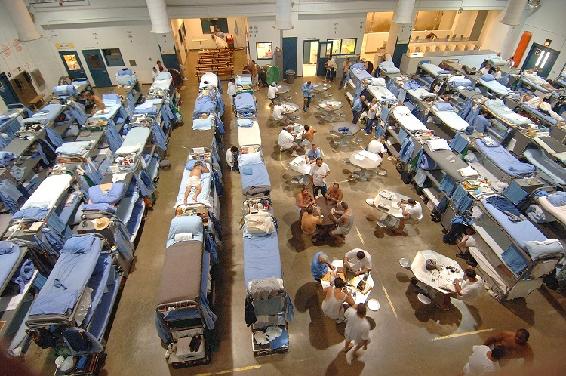8.2: Return to the Rehabilitative Philosophy
- Page ID
- 16074
Since the first prisons were built in American, many changes have occurred. Not all for the better. The United States penal system is currently faced with serious problems, many prisons are underfunded, understaffed and overcrowded. An increase in the crime rate and changes to sentencing laws in the 1990’s led to an increase in incarceration rates. Mandatory minimum and Three Strikes laws has contributed to the growth of prisons population and overcrowding. Another contributing factor to prison overcrowding is recidivism. Recidivism is when an offender is returned to custody for a violation of supervised release or commit a new offense while under supervision.
So, we have a dilemma, prisons are very expensive and ineffective when so many offenders are returned to custody. This shows we have not rehabilitated offenders or deterred crime and more importantly we have also failed to protect the community. At the same time, no one thinks it’s a good idea to open the prison doors and let offenders free. So how do we deal with this epidemic? Some states have been forced to make corrections. In California for example, this led to Supreme Court involvement:
“California's prisons are currently designed to house approximately 85,000 inmates. At the time of the U.S. Supreme Court's 2011 decision in Brown v. Plata, the California prison system housed nearly twice that many (approximately 156,000 inmates). The Supreme Court held that California's prison system violated inmates' Eighth Amendment rights. The Court upheld a three-judge panel's order to decrease the population of California's prisons by an estimated 46,000 inmates. They determined that overcrowding was the primary cause of the inmates' inadequate medical and mental health care. As a result, the California Department of Corrections and Rehabilitation (CDCR) has been working to redistribute inmates and parolees safely and decrease the overall population to the mandated levels.”

This created a situation where California had to make significant changes to the way it managed offenders and incarceration. Their answer to this problem was called Assembly Bill 109 (AB 109) or “2011 Public Safety Realignment,” and changed the seriousness of offenses in the penal code and provided new sentencing requirements for a majority of crimes. It reduced many crimes such and drug use and theft to misdemeanors. Additionally, other crimes previously punishable by prison, were no longer prison eligible. They transferred the responsibility for the incarceration of those offenders back to the counties they were committed. Previously, county jails were only used to incarcerate offenders for short terms (usually a maximum of one year). After the passage of AB 109, offenders could be jailed for up to decades depending on the number of charges.
Another considerable change that came with this bill was the way community supervision was managed. Prior to AB 109, there was two types of supervision, probation (community supervision in lieu of prison) or parole (community supervision after a term in prison was served). After AB 109, the state shifted a significant number of offenders to county supervision and created two additional forms of supervision. Mandatory Supervision was created to supervise offenders who no longer qualified for prison and jailed locally. And Post-Release Community Supervision (PRCS) where offenders identified by CDCR as “non-violent” and could be supervised by county probation officers. This significantly increased the number of offenders the county probation departments were required to supervise.
The idea behind this “realignment” was to focus on rehabilitation and allow offenders to stay locally (either in jail or under supervision) where the community and stake holders could provide better services and reduce recidivism. County funding from the state actually depends on the recidivism rates and rates of prison sentences from each county. Counties receive more money from the state if they can show a reduction in recidivism and a reduction of prison commitments. Counties were required to create committees with community stakeholders to provide evidence-based treatment programs for offenders and demonstrate effectiveness for maximum funding.
Under California penal code section 1230, the Community Correction Partnership (CCP) was created. It required the executive committee be comprised of the following:
- Chief Probation Officer
- Chief of Police
- Sheriff
- District Attorney
- Public Defender
- Presiding Judge of the Superior Court (or his/her designee)
- A representative from either the County Department of Social Services, Mental Health, or Alcohol and Substance Abuse Programs, as appointed by County Board of Supervisors.
The goal of the committee is to ensure the county is doing its best to provide the best offender treatment services. This CCP look for ways to effectively manage services and funding provided by the states. The emphasis is on measurable outcomes and the ability to deliver evidence-based treatment to the offenders. As a result, many probation departments changed practices, reduced caseloads and focused treatment on high risk offenders.
California is not unlike other states. Many are looking for ways to reduce their prison populations. A shift towards a rehabilitative correction system has been a growing movement among many states. More emphasis has been placed on programs offered to offenders while incarcerated, transitional programming for prisoners as they near release and supportive supervision in the community to ensure a better transition. All of these efforts are geared to reducing recidivism and improving the safety of the community through a reduction of crime.
However, for treatment to be effective, correctional professionals – prison guards, correctional counselors and community supervision officers need to be aware of cultural, racial and gender issues that could affect the delivery of treatment and the offenders continued commitment to treatment. In this section we explore multiculturalism in treatment of offenders. This information was initially geared toward the therapeutic professional but can be easily adapted to fit the correctional professional. Despite the dual roles correctional professionals must balance, this information is valuable for developing rapport with offenders and improving outcomes.

